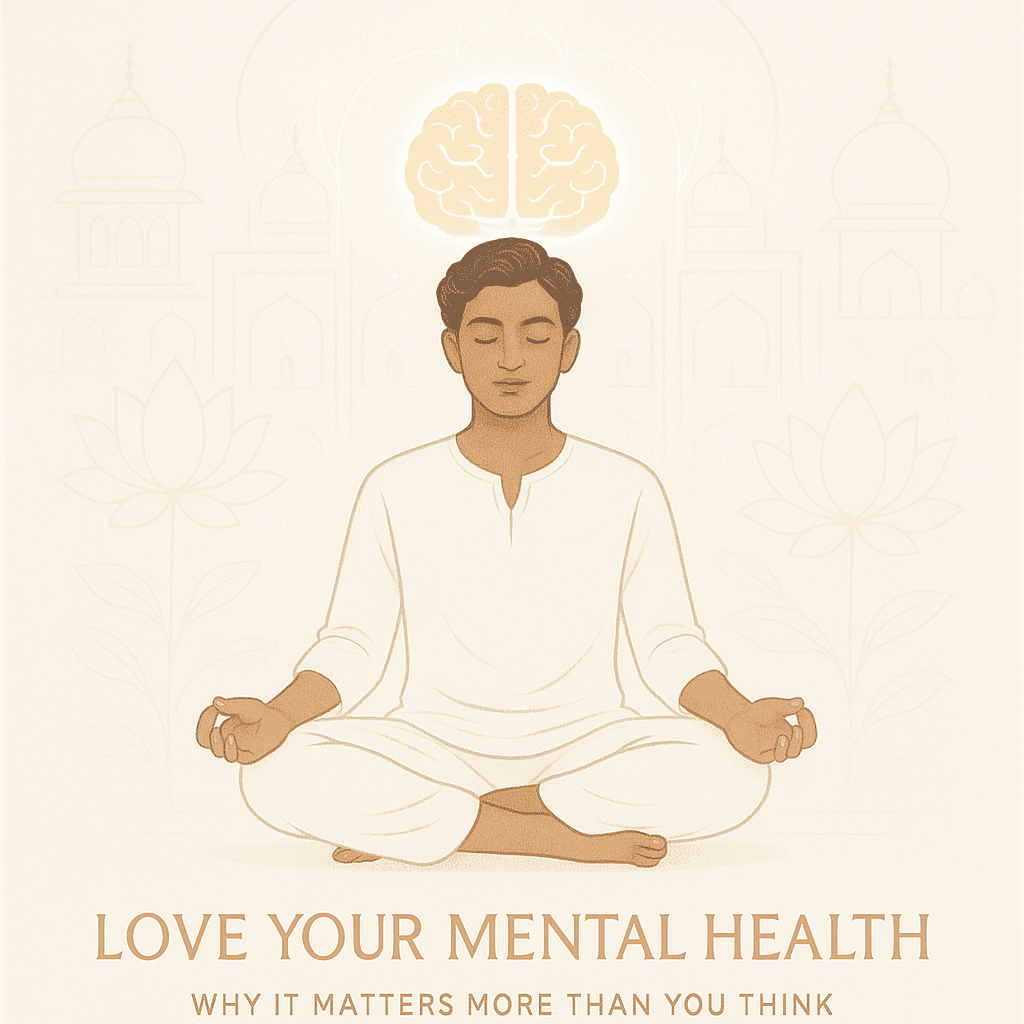
Introduction
Mental health isn’t just a trending term—it’s the foundation of how we think, feel, and navigate daily life. Ignoring it can lead to emotional exhaustion, strained relationships, and even physical health issues. In this article, we’ll explore what affects mental health, how to spot early warning signs, and ways to strengthen your mental well-being.

What Is Mental Health?
Mental health includes your emotional, psychological, and social wellness. It shapes how you think, feel, cope with stress, build relationships, and make choices.
Key Takeaways:
⦁ Mental health goes beyond the absence of illness.
⦁ It includes self-worth, emotional strength, social bonds, and coping ability.
⦁ Good mental health helps you manage everyday ups and downs and enjoy life.
Why Mental Health Matters
⦁ It influences your thoughts, emotions, and actions.
⦁ It affects physical well-being, including sleep, energy, and immunity.
⦁ It plays a big role in how you connect with others and face challenges.
Top 8 Mental Health Issues in India (2025 Overview)
India’s national mental health survey reveals that 1 in 7 people experience mental health conditions. Recognizing them is key to promoting awareness and encouraging early intervention.
1. Depression
Depression (major depressive disorder) is a common and serious mental disorder that negatively affects how you feel, think, act, and perceive the world.
Affects: ~1 in 15 people yearly
Causes: stress, job loss, academic pressure, stigma
Signs: low mood, fatigue, disinterest, sleep/appetite changes
2. Anxiety Disorders
Feeling anxious is a normal part of life. Many people worry about things such as health, money, school, work, or family. But anxiety disorders involve more than occasional worry or fear. For people with these disorders, anxiety does not go away, is felt in many situations, and can get worse over time.
There are several types of anxiety disorders, including:
⦁ Generalized anxiety disorder
⦁ Panic disorder
⦁ Social anxiety disorder
⦁ Various phobia-related disorders
Includes: GAD, panic disorder, social anxiety
Triggers: exams, financial worries, work stress
Symptoms: excessive worry, tension, physical discomfort
3. Substance Use Disorders
Substance use disorder (SUD) is a complex condition in which there is uncontrolled use of a substance despite harmful consequences. People with SUD have an intense focus–sometimes called an addiction–on using a certain substance(s) such as alcohol, tobacco, or other psychoactive substances, to the point where their ability to function in day-to-day life becomes impaired.
Commonly abused: alcohol, tobacco, cannabis, opioids
Rising among urban and rural youth
Strong links to depression, aggression, and suicide
4. Bipolar Disorder
Bipolar disorders are mental health conditions characterized by periodic, intense emotional states affecting a person’s mood, energy, and ability to function.
Main Types:
⦁ Bipolar I disorder
⦁ Bipolar II disorder
⦁ Cyclothymic Disorder
5. Schizophrenia and Psychotic Disorders
Psychotic disorders are a group of serious mental illnesses that all have signs of psychosis. Psychosis is a cluster of symptoms, not an illness. It’s sometimes described as “losing touch with reality.” What’s likely happening during psychosis is that the person has disruptions in their thoughts and the way they interpret their thoughts that makes it hard for them to recognize what is real and what isn’t.
Signs: hallucinations, delusions, disorganized thoughts
6. Obsessive-Compulsive Disorder (OCD)
OCD features a pattern of unwanted thoughts and fears known as obsessions. These obsessions lead you to do repetitive behaviors, also called compulsions. These obsessions and compulsions get in the way of daily activity and cause a lot of distress.
More prevalent in cities
7. Post-Traumatic Stress Disorder (PTSD)
PTSD is a psychiatric condition that may occur in people who have experienced or witnessed a traumatic event or series of traumatic events.
Causes: abuse, accidents, violence, disasters
Symptoms of PTSD:
⦁ Intrusion
⦁ Avoidance
⦁ Changes in cognition and mood
⦁ Changes in arousal and reactivity.
8. Eating Disorders
It is a behavioral condition characterized by severe and persistent disturbance in eating behaviors and associated distressing thoughts and emotions. They can be serious conditions affecting physical, psychological, and social function.
Includes: anorexia, bulimia, binge eating
Main Causes and Risk Factors
1. Biological:
Family history, brain imbalances, physical illness, substance use, poor diet/sleep
2. Psychological:
Trauma, prolonged stress, low self-esteem, personality traits
3. Social:
Isolation, poverty, discrimination, family issues, societal pressure, unstable housing
Common Symptoms and Their Impact
⦁ Persistent sadness or lack of interest
⦁ Difficulty concentrating
⦁ Excessive fears, guilt, or mood swings
⦁ Withdrawing from people or activities
⦁ Fatigue, sleep troubles, or loss of appetite
⦁ Hallucinations, paranoia, or irrational thinking
⦁ Alcohol or drug problems
Anger, violence, or suicidal thoughts
Spotting the Signs Early
Watch out for:
⦁ Sleep or appetite changes
⦁ Mood fluctuations
⦁ Social withdrawal
⦁ Declining performance at work or school
⦁ Confusion or illogical thinking
⦁ Heightened sensitivity
⦁ Apathy and disengagement
⦁ Nervousness or erratic behavior
Encourage those affected to:
⦁ Seek professional evaluation
⦁ Learn about mental health conditions
⦁ Try supportive counselling and stress management
⦁ Get continuous support for more serious cases
BONUS TIPS: Lesser-Known but Helpful
1. Name Your Inner Critic
Give your negative thoughts a goofy name to lessen their grip.
2. Create a Mental Health First-Aid Kit
Include soothing items like journals, calming scents, affirmations, and music.
3. Try the 3-3-3 Rule for Anxiety
⦁ Name 3 things you see
⦁ Identify 3 sounds you hear
⦁ Move 3 parts of your body
4. Text Yourself Like a Friend
Write yourself the kind messages you’d send a loved one.
5. Keep a ‘Done’ List
Track what you’ve accomplished, no matter how small, to boost morale.
PRO TIPS: Long-Term Mental Health Strategies
1. Track Patterns, Not Just Feelings
Use mood tracking tools to identify triggers and trends.
2. Practice Radical Acceptance
Accept what you can’t change without judgment to reduce distress.
3. Control Your Input
Be selective about what you watch, read, or listen to—it affects your mood.
4. Start with Routine, Not Motivation
Action fuels motivation. Build habits that keep you going.
5. Use Visualization as Mental Rehearsal
Imagine calmly handling tough situations—it trains your brain for real life.
Conclusion
Mental health is a complex challenge, but taking care of it is essential.
According to a research paper on the impact of mental health on physical health, mental disorders can significantly worsen the progression and outcomes of chronic illnesses such as diabetes, heart disease, and cancer. The study also notes that individuals suffering from severe mental health conditions often have a life expectancy 10 to 20 years shorter than the general population. These findings emphasize the critical importance of maintaining good mental health.

